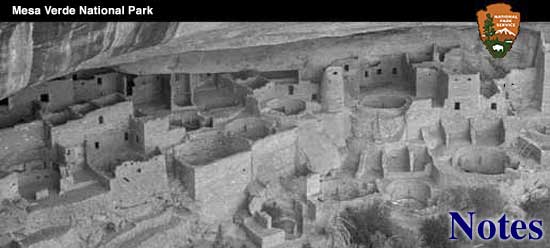

|
Early Man in America, at the hunt, is portrayed in the new Folsom diorama that was installed in the Mesa Verde museum last spring. With the completion of this diorama, park visitors have the privilege of viewing man hunting bison as he presumably did twelve or fifteen thousand years ago. It is sunset. The twilight blue of the sky blends with the powder blue of a deep arroyo head. Far across the rolling plain the smoke of volcanic Capulin Mountain drifts lazily in the evening breeze. Close at hand four bison stand at their favorite water hole. Down the old bison trail stalk six bronzed hunters with long darts poised on their atlatls (dart-throwers). One stealthy warrior kneels behind a sagebrush to escape detection by the wary animals, while far above on a ledge, another staggers under the weight of a large stone which he will hurl down on the bison. All are awaiting the signal at which swift darts, projected by their atlatls, will find marks in the huge beasts. The little diorama portrays only this part of the hunt. However, we can imagine that the deepening twilight will find six excited hunters hard at work butchering the kill, while night will witness a file of weary man trudging slowly back to camp, burdened with food and potential clothing. The days will pass, as will years, centuries and, eventually, millenia. The bones of the beasts will whiten, become covered over with soil, and fossilization will begin. Broken dart points will remain associated with these bones—small but important clues to the establishment of Early Man in America. Volcanic Capulin Mountain dies a smouldering death, but its cold crater continues to look down upon other roving bands of hunters. These later Indians hunt the modern bison or buffalo. The points associated with the bones of these animals are found scattered far and wide over the Great Plains area. The pageant continues. With the advent of the white man and his domesticated cattle the buffalo disappears. While rounding up stray cattle a rancher discovers that a recent flood has exposed deeply buried bones, evidence of the bison kill of many thousands of years ago. Its significance is now for scientists to interpret. The diorama, probably the first ever attempted of Folsom Man, presents a reconstruction based on two important discoveries: (1) nineteen finely flaked Folsom dart or spear points, whole or fragmentary, with a longitudinal groove or fluting on each side, found in association with (2) the bones of more than thirty Bison occidentalis, a species which palaeontologists agree became extinct at least 12,000 or more years ago. Because of the maximum thirteen foot depth of the finds and because the points and the bones were found in Late Pleistocene gravels, undisturbed until the fortunate exposure by floods in 1925, it is generally accepted that the evidence proves the existence of nomadic hunters in America at that early age. The Folsom findings are further substantiated by excavations during the past three summers of Dr. Frank H. H. Roberts, of the Bureau of American Ethnology, on the Lindenmeier Ranch, near Fort Collins, Colorado, and the discoveries of Dr. E.B. Howard, of the University of Pennsylvania Museum, in the dry lake beds between Clovis and Portalis, New Mexico. The original Folsom site was discovered by chance in 1925, by F. J. Howarth and Carl Schwachheim of Raton, New Mexico. Excavations were initiated by the Colorado Museum of Natural History of Denver, Colorado and later assisted by the American Museum of Natural History of New York. Other reputed Late Pleistocene finds include Folsom-like points in association with remains of extinct species of bison in Colorado, Nebraska, Kansas, Texas, and New Mexico, and even of mammoth in Colorado and Nebraska. In addition, many points related to the Folsom type have been found on the surface or in sandy "blowouts" in many parts of the United States. The Mesa Verde museum presents this diorama of Folsom Man with full knowledge that certain features may require change or modification as new findings alter the present knowledge of early men in America. The physical type of Folsom Man cannot be ascertained until authenticated human remains are found, a matter that may involve years of patient and relentless search. The exact method of hafting the distinctive Folsom points to the dart or spear shafts is not known, nor is it known whether these early men used atlatls and darts, or simply spears that they threw by hand. In the diorama both methods of projection are shown Certain liberties have of necessity been taken in the making of this diorama. The whole effort is to present to the park visitors the fact that for many thousands of years Indians have been in America. As the years pass new evidences of Folsom Man will be found and the diorama will be changed to conform with the new knowledge of these early Americans. The Folsom diorama was planned by the museum staff and was executed, under competent supervision, at the Western Museum Laboratories of the National Park Service at Berkeley, California, by artists on relief employment.
| ||||||
| <<< Previous | > Cover < | Next >>> |
vol7-2f.htm
14-Oct-2011